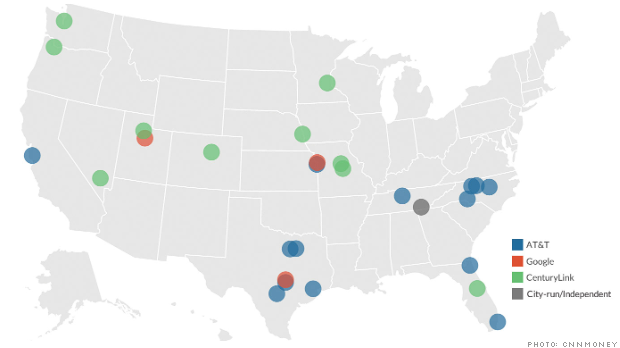Two Big Reasons CNN Money Is Only Half Right About Gigabit Broadband Expansion

CNN Money’s colorful but misleading map shows both real and imaginary private gigabit expansion but misses public gigabit networks.
Broadband internet coverage in the United States is still pretty uneven. While some, mainly rural, communities are scrambling to connect to the 21st century using slow, old, and unreliable tech, some urban areas are dashing forward at over 1000 Mbps. The list of lucky cities with gigabit connections is growing, as CNN Money reports, but it’s not growing in the way that CNN indicates.
The article is right that gigabit connections are, slowly, starting to meander their way into a number of cities around the United States. But the map is misleading in a couple of big ways: it overplays the current contributions of big telecom businesses, and misses a chance to highlight smaller success stories.
1.) Promises Aren’t Connections
There sure are a lot of dots for AT&T and for CenturyLink on that map! They must be expanding like mad!
Well, yes and no. Both companies have plans for expansion in several cities, but haven’t built out all their networks or connected many subscribers yet.
Currently, AT&T “U-verse with GigaPower” service is available in three cities, all in Texas. They are “confirmed” to be installing service in another 11 cities sometime in the hopefully not-too-distant future. The intent to connect some of those cities was just announced as recently as this week. Plan information, pricing, and availability won’t be available to potential subscribers for some time.
Additionally, in the three cities — Austin, Dallas, and Fort Worth — where AT&T does currently operate ultra-high-speed GigaPower networks, not all customers are yet seeing actual gigabit speeds, although the company does plan to reach that level during 2014.
The CenturyLink dots are a little more accurate than the AT&T dots. Just this month, the company announced that they were immediately launching residential fiber in eight cities and expanding it in their existing three. Another six cities are getting business-only access. However, even in the 11 cities where CenturyLink now provides fast fiber access, the service is new and still only available in certain areas.
2.) Municipal Broadband
The article says that, “AT&T, Google, and CenturyLink, have been the main drivers of ultra-fast Internet for home customers.” And as far as private investment goes, that’s true. But big telecom, cable, and internet companies aren’t the only game in town.
The CNN map has exactly one purple dot, representing publicly-owned networks, on their map and it’s splatted right in Chattanooga, Tennessee.
Chattanooga has indeed had tremendous success with their citywide, publicly-owned fiber network. The chairman of the FCC has held the city up as a shining example of why municipal broadband networks should be allowed to thrive despite state-level laws currently blocking them.
But laws in 20 states haven’t blocked all public fiber networks. According to the Institute for Local Self-Reliance, which tracks and advocates for the expansion of municipal broadband networks, there are roughly 90 communities out there where fiber-to-the-home is available for “most or all” of the residents. And of those, over 40 communities in 13 states offer gigabit connections.
Granted, localities cluster together on a national-level map so asking for 40+ purple dots is really a bit much. But at least 12 other states around the country should have an indicator in them somewhere and don’t.
Where you can get blazing-fast Internet speeds [CNN Money]
Want more consumer news? Visit our parent organization, Consumer Reports, for the latest on scams, recalls, and other consumer issues.

